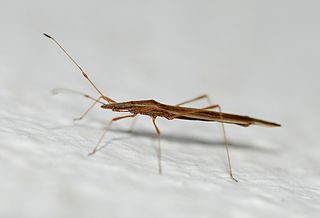
The genus Neides is a small but common Old World group of stilt bugs; the name has precedence of the junior synonym name Berytus which Fabricius coined for the same taxon in 1803. It formerly included one North American species, which has been removed to its own genus, Neoneides.

Berytidae is a family of the order Hemiptera, commonly called stilt bugs or thread bugs.
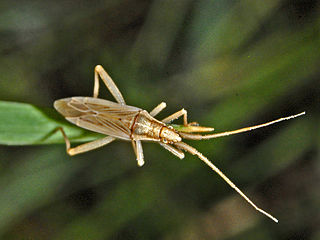
Stenodema holsata is a species of bug from the family Miridae.

Malacocoris chlorizans is a species of plant bugs belonging to the family Miridae, subfamily Orthotylinae.
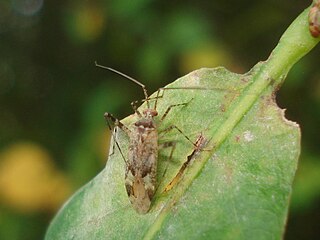
Phytocoris tiliae is a species of plant bugs belonging to the family Miridae, subfamily Mirinae.
Phytocoris longipennis is a species of plant bugs belonging to the family Miridae and subfamily Mirinae.
Phytocoris dimidiatus is a species of plant bugs belonging to the family Miridae, subfamily Mirinae.

Orthops basalis is a species of plant bugs belonging to the family Miridae, subfamily Mirinae that can be found everywhere in Europe except for Azores, Bosnia and Herzegovina Faroe Islands, Iceland and Cyprus. then east across the Palearctic to Central Asia and Siberia.

Orthops campestris is a species of plant bugs belonging to the family Miridae, subfamily Mirinae, that can be found everywhere in Europe except for Azores, Faroe Islands, Iceland and African islands such as Canary Islands and Cyprus. and across the Palearctic to Central Asia and Siberia.

Gonocerus acuteangulatus is a herbivorous species of true bug in the family Coreidae. It is commonly known as the box bug in the UK as it once only occurred in Box Hill in Surrey where it fed on box trees.

Sehirus luctuosus, the Forget-me-not Bug, is a burrowing shieldbug belonging to the family Cydnidae. It is found from Europe to Central Asia.In Central Europe it is widespread and not uncommon. They are found in the Alps on sunny slopes up to almost 2000 meters above sea level.

Eurygaster testudinaria is a Palearctic shieldbug. It occurs in Europe from the Northern Mediterranean to southern Scandinavia, and East through Central Asia to northern China and Japan.
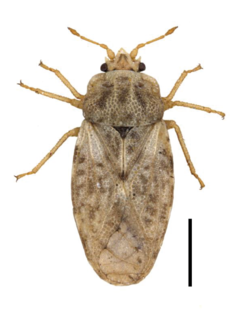
Piesma maculatum is a true bug species found from North Africa to southern parts of Scandinavia and the South of the British Isles then across the Palearctic to the Black Sea region to Central Asia, China and Japan. In Central Europe it is widespread and generally the most common species of the family Piesmatidae.

Metatropis rufescens is a species of true bugs. The species is found in Europe, with the exception of the far North and South then East to the Black Sea region and across the Palearctic to Siberia. In Central Europe it is common, but it is not found everywhere. In the British Isles it is common in the South including Wales and Ireland. It occurs in shady, mostly moist habitats in deciduous forests.

Plesiodema pinetella is a true bug. The species is found across Palearctic from Europe and Western North Africa East to Siberia and Central Asia.
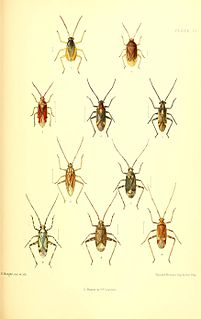
Monalocoris filicis is a true bug in the family Miridae. The species is found in Europe from Ireland in the West and including the northern edge of the Mediterranean and the East across the Palearctic to Central Asia, Korea and Japan. In Central Europe, it is widespread and generally common. In the Alps, it occurs up to the edge of the forest. Habitats are deciduous and coniferous forests and moist, open habitats such as bogs or the shores of streams.

Plagiognathus arbustorum is a species of insects in the family Miridae, the plant bugs.

Blepharidopterus angulatus, the black-kneed capsid, is a species of plant bug in the family Miridae. It is found in North Africa, Europe East across the Palearctic to Central Asia and in North America.

Megalonotus praetextatus is a species of seed bug in the family Rhyparochromidae.

Piesma is a genus of ash-grey leaf bugs, insects of the family Piesmatidae. It is the type genus of the family.


















